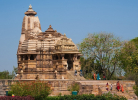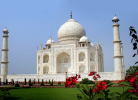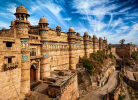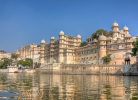Agra Fort (Red Fort)
-
Famous For Photo Fanatics, History Buffs, Experience Seekers
-
Duration of Visit 2 to 3 hours
-
Fee 750 per person
-
Visiting Time All days 6:00 AM - 6:00 PM (Friday Closed)
Although Taj Mahal overshadows the beauty and importance of Agra Fort, this fine example of Mughal beauty stands etching in every traveler’s memory. Everyone visiting Agra makes it a point to visit Agra Fort along with Taj Mahal. These two are the top monuments of the country.
This is a cluster of sandstone and marble palaces enveloped in one large fortress, defining power and defense. Are you planning to visit Agra Fort during your next visit? Here is everything that you need to know. Read on: How to Explore the Endless Beauty of Agra by Car
Where is Agra Fort Located?
Agra Fort is located in Agra city of India. It is located just 2.5 km away from Taj Mahal. The fort is just 15 minutes away from Agra railway station and little farther from the bus stand. You can easily get cycle rickshaw, auto, cab or bus from any part of the city to Agra Fort.
Suggested Tour : 2 Days – Agra Taj Mahal tour by Car from Delhi
Why is Agra Fort Famous?
Also called as the Red Fort (do not confuse it with the Red Fort of Delhi), this 16th century fortress is located closer to Yamuna River in Agra. This fort was built as a military base by Akbar and was converted into royal residence by Jehangir, his descendant. This fort was designated with the title of World Heritage Site by UNESCO in 1983.
This structure is very famous for its intricate architectural beauty, which took 4000 workers over the span of eight years to build. This fort’s location was chosen for a strategic defense location. Since the ancient times, this fort has been a gem in the eyes of all the rulers and invaders.
- Three main dynasties have ruled this fort and you can see their significances in the architecture of this fort.
- Since ancient times, this fort was a symbol of resilience, power and pride. It was one of the most impregnable forts in the past.
- This is a classic icon of the lavishing lifestyle of Mughals. Starting from Belgian glass to premium sandstones, only the elite elements were used in the construction of this fortress
- This is an important example to the fact that Hinduism and Islam thrived hand-in-hand during ancient times. This Islamic structure has many Hindu temples.
- Scholars from Middle East and the central part of Asia were eager to visit this fort for its beauty and literacy elements.
Suggested Tour : 5 Days – Exclusive Taj Mahal Tour
History of Agra Fort
Agra Fort has a rich history. This fort has been ruled by many emperors in the past and has gone through considerable changes in the appearance. The fort region belonged to Ibrahim Lodi and had the palace of Lodi at the very location, made entirely of bricks. In 16th century, Babur, first Mughal ruler defeated Ibrahim Lodi and captured the palace. He then converted the palace into a small fort and added many modifications to the fort like huge step-well. Due to its strategic location, the fort became an important landmark for the Mughals. After Babur’s death, the Mughal Empire was a little shaken and other dynasties started to attack the fort. In 1540, Sher Shah Suri captured the fort from Humayun and made a few changes. Later, it was owned by Hemu Vikramadiya.
Humayun’s son, Akbar defeated Hemu and took over the fort. By that time, the fort was disintegrating from its original beauty. The bricks from the fort were no longer strong enough to withhold the structure. Thus, Akbar decided to re-build the fort with sandstones. Akbar built many palaces, courtyards and other structures of the fort.
When Shah Jahan came to the throne, he commissioned to destroy many palaces inside the fort to make way for his marble palaces. After his dethrone, the fort went to the control of his son, Aurangazeb. He was thrown out of the throne by Maratha Empire, then the control went to Durrani Empire and again came to the control of Maratha Empire. In 1785, the Maratha Empire fell to ground in the battle with British, during the Second Anglo Maratha War. British took control of the fort and used it as a barrack and army site until 1947, after which, it became the property of Indian Government.
Suggested Tour : 10 days – Heritage with Taj Mahal tour
Architectural beauty of Agra Fort
Roughly, it is a semi-circle fort. The base of the Agra Fort looks into the riverbank of Yamuna. The outer wall of the fort is made out of massive red sandstones built in double battlement style. The perimeter of the wall is around 2 km. It is crafted with lofty bastions and curves. Walls are 70 feet high to avoid intruders to easy access the fort. This fort has four gates. Out of the four, Delhi Gate and Lahore Gate are quite common. Delhi Gate was used by the royals and it is also the security gate, in case of invasion. From the main gate, you can find an inner gateway, which is called as Elephant Gate. The gate gets its name from its strength, which allows it to stand even when challenged by a war elephant. The Delhi Gate is used by Indian army and is not open to public use.
Tourists have to enter via the southern gate, Amar Singh Gate. You will right away find a ticket counter. Walk past the ticket counter and you would reach the first courtyard with Jehangir Palace. This is one of the very few surviving palaces inside the fort. Right in front of Jehangir Palace, you will find Hauz-i-Jehangir, a large bowl carved out of a single stone. This large bowl was used in the past for bathing.
As you walk towards the eastern side, you will find Khas Mahal, a marble pavilion and pool, which was the residence of Shah Jahan. From this palace, you can get a good view of Taj Mahal. The second courtyardis called as AnguriBagh. This garden runs downs to a flight of stairs, which would lead to underground passages and rooms. To the northeast of the courtyard, you will find Mirror Palace. To the north, you can spot the octagonal tower, Mathamman Burj. This is the place where Shah Jahan was imprisioned. You can get a good view of Taj Mahal from this palace.
Walk towards the third courtyard and you will find Hall of Private Audience, which once hosted the Peacock Throne of Shah Jahan. Walk towards the northern side of the courtyard and you will find Nagina Masjid, mosque for the women of royal family. Further, you will find Ladies’ Bazaar and Hall of Public Audience. You will find a small grave of John Colvin, a lieutenant governor of British, who died inside the fort. That is the end of the access to public.
- Jehangir’s Hauz – Monolithic tank, which was built by Jehangir. It was used in the past for bathing. Now, it is connected with Bengali Mahal.
- Bengali Mahal – This is a palace of Akbar, which is said to have many secret underground buildings.
- Akbar Mahal – this is the palace of Akbar, which is in ruins now. Akbar lived his final moments in this palace
- Babur’s Baoli – This is the first modification made to the fort by Mughals. This stone step well was an important source of water for inmates of the fort.
- Shahjahani Mahal – This was the first palace, which was in sandstone and was modified into marble palace by Shah Jahan.
- Nagina Masjid – This is a private mosque built by Shah Jahan for the women of the fort. This mosque is entirely made of white marbles.
- Ghaznin Gate – This gate is a part of Mahmud of Ghazni tomb. The gate was moved to its current location by British.
- Diwan-i-Am – This is the Hall of Public Audience, the place where the king talks to his subjects, gets petitions and others. This is a red sandstone structure, which is shell-plastered to look like it is made of white marble.
Agra Fort has many labyrinth of passages and tunnels right underground. The emperors dedicated resources for these tunnels as an escape route and for other defensive reasons. One of the known tunnels connect the fort with the banks of River Yamuna. These tunnels and underground passages are closed to public.
Best Time to Visit Agra Fort
Agra Fort is at prime beauty throughout the year. The weather has very little to do with the beauty of the place. However, the entire fort covers 380,000 square meter. This is quite a large area to explore. April to June would have the hottest and humid temperature. This can cause dehydration or fatigue while exploring. Moderate rainfall is common during July to September. Not everyone will be comfortable in exploring the place in rain. Thus, it is best to visit the place from October to March. This is the winter season of the region and the climate will be pleasing for exploring the fort. Moreover, the sky will be clear throughout the day and you would be able to spot the view of Taj Mahal from Agra Fort with ease.
Visiting Timing of Agra Fort
The fort is open from Saturday to Thursday, from 6 in the morning to 6 in the evening. It would take a maximum of three hours to explore the entire fort. Thus, choose early mornings or late evening to avoid the sun
Entry Fee of Agra Fort
- Entry fee for Indian adult - INR 40
- Entry fee for foreign adult – INR 550
- Entry fee for adults from SAARC/ BIMSTEC nations – INR 90
- Entry fee for children below the age of 15 – Nil
Are you planning to add more luxury to your vacation to Agra? Choose luxury trains, which cover Agra in the itinerary. You get to explore this classic paradise in a style suitable for the blue bloods.
Suggested Tour : Palace on Wheels Iconic Itinerary
















